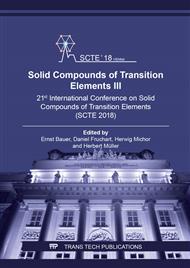[1]
M. Schwall and B. Balke: Phys. Chem. Chem. Phys. 15, (2013), p.1868.
Google Scholar
[2]
M. Mikami, Y. Kinemuchi, K. Ozaki, Y. Terazawa, and T. Takeuchi, Journal of Applied Physics 111, 093710 (2012).
DOI: 10.1063/1.4710990
Google Scholar
[3]
T. Graf, C. Felser, and S. S. Parkin: Progress in Solid State Chemistry 39, (2011), p.1.
Google Scholar
[4]
M. Weinert and R. E. Watson: Phys. Rev. B 58, (1998), p.9732.
Google Scholar
[5]
Y. Nishino, H. Kato, M. Kato, and U. Mizutani: Phys. Rev. B 63, (2001), p.233303.
Google Scholar
[6]
I. Knapp, B. Budinska, D. Milosavljevic, P. Heinrich, S. Khmelevskyi, R. Moser, R. Podloucky, P. Prenninger, and E. Bauer: Phys. Rev. B 96, (2017), p.045204.
Google Scholar
[7]
Y. Nishino, S. Deguchi, and U. Mizutani, Phys. Rev. B 74, 115115 (2006).
Google Scholar
[8]
H. Kato, M. Kato, Y. Nishino, U. Mizutani, and S. Asano, Journal of the Japan Institute of Metals 65, 652 (2001).
Google Scholar
[9]
K. Renard, A. Mori, Y. Yamada, S. Tanaka, H. Miyazaki, and Y. Nishino, Journal of Applied Physics 115, 033707 (2014).
Google Scholar
[10]
C. S. Lue, C. F. Chen, J. Y. Lin, Y. T. Yu, and Y. K. Kuo, Phys. Rev. B 75, 064204 (2007).
Google Scholar
[11]
M. Mikami and K. Kobayashi, Journal of Alloys and Compounds 466, 530 (2008).
Google Scholar
[12]
M. Mikami, S. Tanaka, and K. Kobayashi, Journal of Alloys and Compounds 484, 444 (2009).
Google Scholar
[13]
M. Mikami, M. Inukai, H. Miyazaki, and Y. Nishino, Journal of Electronic Materials 45, 1284 (2016).
Google Scholar
[14]
P.-C. Wei, T.-S. Huang, S.-W. Lin, G.-Y. Guo, and Y.-Y. Chen, Journal of Applied Physics 118, 165102 (2015).
Google Scholar
[15]
H. Al-Yamani and B. Hamad, Journal of Electronic Materials 45, 1101 (2016).
Google Scholar
[16]
Y. Wang and J. P. Perdew: Phys. Rev. B 44, (1991), p.13298.
Google Scholar
[17]
I. A. Abrikosov and H. L. Skriver: Phys. Rev. B 47, (1993), p.16532.
Google Scholar
[18]
A. Ruban and H. Skriver: Computational Materials Science 15, (1999), p.119.
Google Scholar
[19]
S. Khmelevskyi, E. Simon, and L. Szunyogh: Phys. Rev. B 91, (2015), p.094432.
Google Scholar
[20]
S. Khmelevskyi: Phys. Rev. B 94, (2016), p.024420.
Google Scholar
[21]
I. Turek, V. Drchal, J. Kudrnovsky, M. Sob, and P. Weinberger, Electronic structure of disordered alloys, surfaces and interfaces (2013).
DOI: 10.1007/978-1-4615-6255-9
Google Scholar
[22]
E. Bauer, S. Berger, C. Paul, M. D. Mea, G. Hilscher, H. Michor, M. Reissner, W. Steiner, A. Grytsiv, P. Rogl: Phys. Rev. B 66, (2002), p.214421.
Google Scholar
[23]
H. J. Goldsmid and J. W. Sharp: Journal of Electronic Materials 28, (1999), p.869.
Google Scholar
[24]
Y. Kawaharada, K. Kurosaki, and S. Yamanaka, Journal of Alloys and Compounds 349, 37 (2003).
Google Scholar


